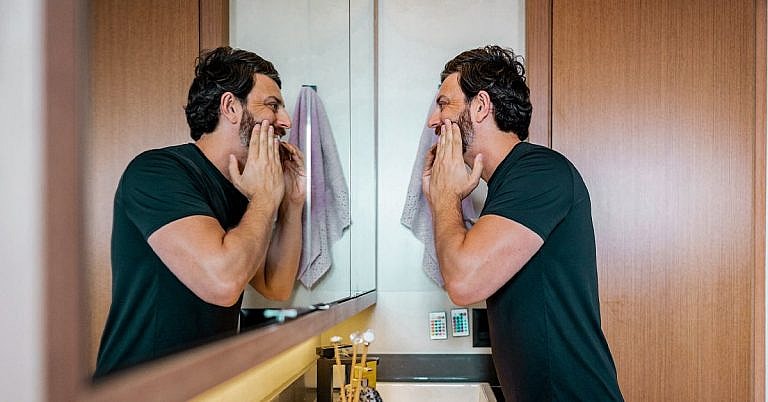Lumbar Degenerative Kyphosis: Symptoms, Treatment, and More
Older adults, particularly those with a history of stooped or physically demanding work, are at higher risk for developing LDK.
Lumbar degenerative kyphosis (LDK) is a spinal condition often seen in older people. It’s characterized by an abnormal forward curvature of the lower back due to degenerative changes in the spine’s bones and muscles.
The condition often leads to lower back and leg pain, as well as a noticeable hunched posture.
What causes lumbar degenerative kyphosis
Lumbar degenerative kyphosis happens when the spine wears down with age. This wear and tear affects the discs and joints in the lower back, making them deteriorate. The muscles around the spine also weaken and get fatty.
Several occupational factors can directly contribute to the development and progression of LDK.
These include:
Symptoms of lumbar degenerative kyphosis
The symptoms of lumbar degenerative kyphosis include the following:
Treatment options for lumbar degenerative kyphosis
The first-line treatment for LDK typically includes conservative approaches. These treatments focus on managing symptoms and improving the quality of life without surgery. The primary conservative treatments are:
Surgery is considered for people with severe symptoms like difficulty walking, constant pain, or serious posture problems that don’t get better with other treatments.
Here are the most common types of surgery for LDK:
Research shows that measuring pelvic tilt while lying down (supine pelvic tilt or sPT) before surgery is important. If there’s a big difference between sPT and the pelvic tilt after surgery, it can lead to post-surgical problems.
Properly assessing sPT helps doctors plan the surgery better and reduces the risk of complications.
Complementary therapies
Several complementary therapies can be recommended for managing LDK. These therapies can help alleviate symptoms and improve overall quality of life:
Are treatments for LDK covered by insurance or Medicare?
Many health insurance plans, including Medicare, cover treatments for LDK if they’re deemed medically necessary. This often includes diagnostic imaging, physical therapy, medications, and surgical procedures.
It’s always a good idea to verify coverage details with the specific insurance provider or Medicare to confirm what is included in your plan.
ICD code for lumbar degenerative kyphosis
In the ICD-10 coding system, lumbar degenerative kyphosis is classified under codes related to spinal deformities and degenerative changes.
What should you avoid if you have lumbar degenerative kyphosis?
Here are the activities to avoid if you have lumbar degenerative kyphosis:
Takeaway
Lumbar degenerative kyphosis is a spinal condition in which the lower back curves in an abnormal way due to wear and tear.
Managing LDK involves treatment, physical therapy, and avoiding activities that stress the spine, like heavy lifting and high impact exercises. Early treatment and careful planning for surgery, if needed, can improve results and quality of life.
Hey kiddo! So, you know how sometimes we sometimes have to bend and lift things? Like when we pick up our toys or help Mom and Dad carry heavy boxes? Well, some people have jobs that make them do that a lot, like construction workers or gardening.
Over time, their spines can get a little worn out like an old toy, and this can cause problems with their back and legs. Imagine having an extra heavy toy that we always have to carry around, and it’s hard to move or walk because of how heavy it is!
That’s kind of what happens with a condition called lumbar degenerative kyphosis (it’s a big name, isn’t it?). It’s when the spine in our lower back gets a little bit curved or bent, which can hurt and make it harder to move around.
To make things easier, we can do some special exercises to strengthen our muscles and keep our backs straight. If it’s really bad, sometimes we might even need to wear a special back brace to help straighten up.
But don’t worry, there are lots of things we can do to help! Like doing fun exercises and seeing a doctor if we need surgery. It’s like getting a new toy that’s easy to play with!
Remember to always take care of your back and be gentle with your spine. Just like taking care of your toys, we can take care of our bodies!
Certainly! Here is a sample of a Frequently Asked Questions (FAQ) section that is optimized for SEO and formatted with questions as H3 HTML tags. Please note that the answers are concise and straightforward to ensure easy understanding:
“`html
What is Lumbar Degenerative Kyphosis?
Lumbar Degenerative Kyphosis is a condition characterized by an abnormal curvature of the lower spine, often resulting from degenerative changes in the vertebrae and intervertebral discs.
What are the common symptoms of Lumbar Degenerative Kyphosis?
Common symptoms include lower back pain, a noticeable hunch or curve in the lower back, stiffness, difficulty maintaining an upright posture, and potentially nerve-related symptoms like tingling or numbness in the legs.
What causes Lumbar Degenerative Kyphosis?
This condition is primarily caused by the natural aging process, which leads to degeneration of spinal structures such as discs and vertebrae. Other contributing factors may include osteoporosis, previous spinal injuries, or genetic predisposition.
How is Lumbar Degenerative Kyphosis diagnosed?
Diagnosis is typically made through a combination of physical examination, patient history, and imaging tests such as X-rays, MRI, or CT scans to assess the curvature and integrity of the spine.
What are the treatment options for Lumbar Degenerative Kyphosis?
Treatment options range from conservative methods like physical therapy, pain management, and exercise to improve posture and flexibility, to more invasive procedures like surgical intervention for severe cases.
Can Lumbar Degenerative Kyphosis be prevented?
While some factors such as aging are unavoidable, maintaining a healthy lifestyle with regular exercise, a balanced diet, and proper posture can help reduce the risk of developing this condition.
Is surgery always required for Lumbar Degenerative Kyphosis?
No, surgery is usually considered only when conservative treatments fail to relieve symptoms or if the spinal curvature significantly interferes with quality of life.
How effective is physical therapy for Lumbar Degenerative Kyphosis?
Physical therapy can be very effective in managing symptoms by improving flexibility, strength, and posture, thus helping to reduce pain and improve function.
What lifestyle changes can help manage Lumbar Degenerative Kyphosis?
Adopting a regular exercise routine, practicing good posture, maintaining a healthy weight, and participating in activities that strengthen the core and back muscles can help manage and alleviate symptoms.
“`
This format ensures that users and search engines can easily understand the context and locate relevant information.







